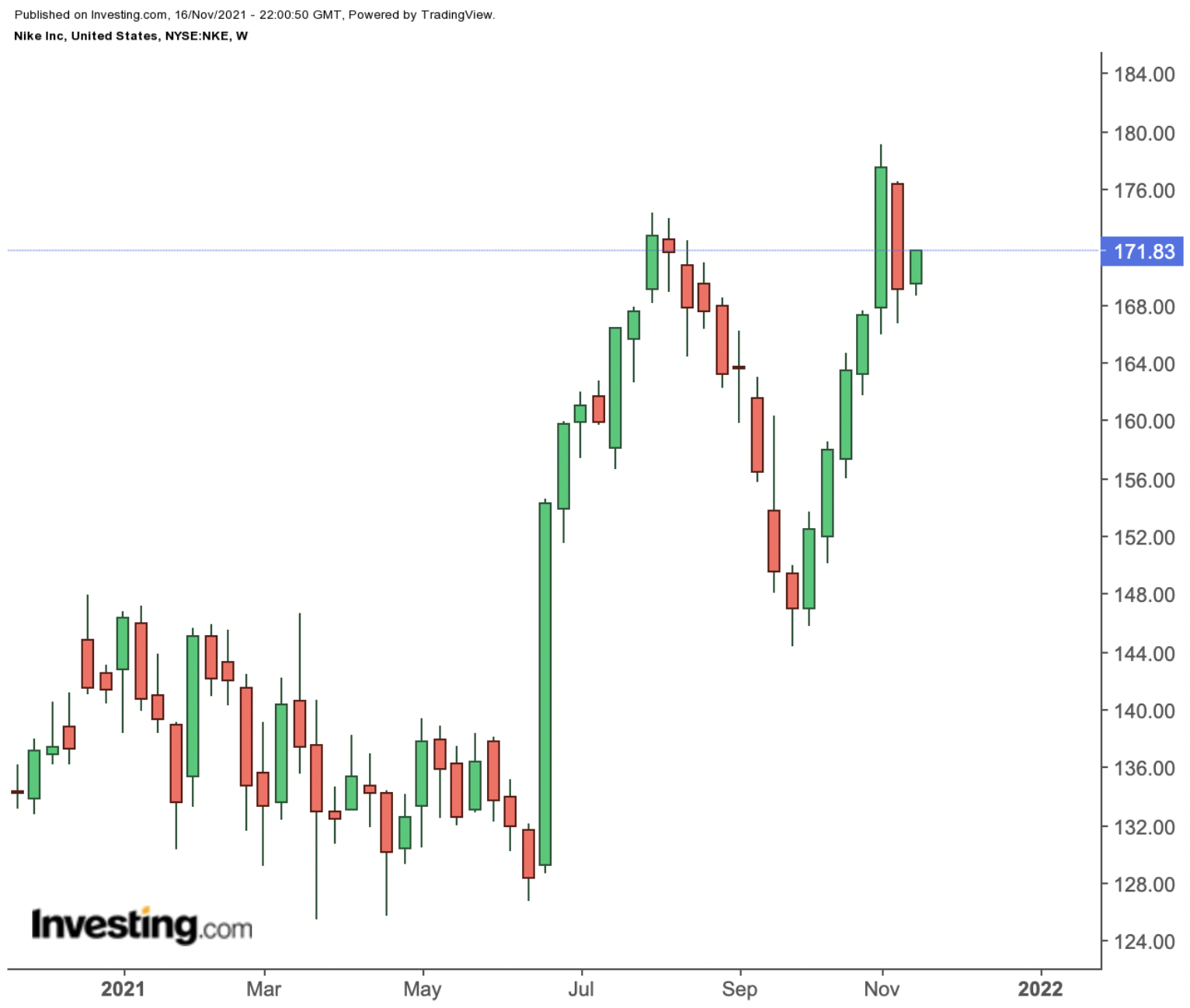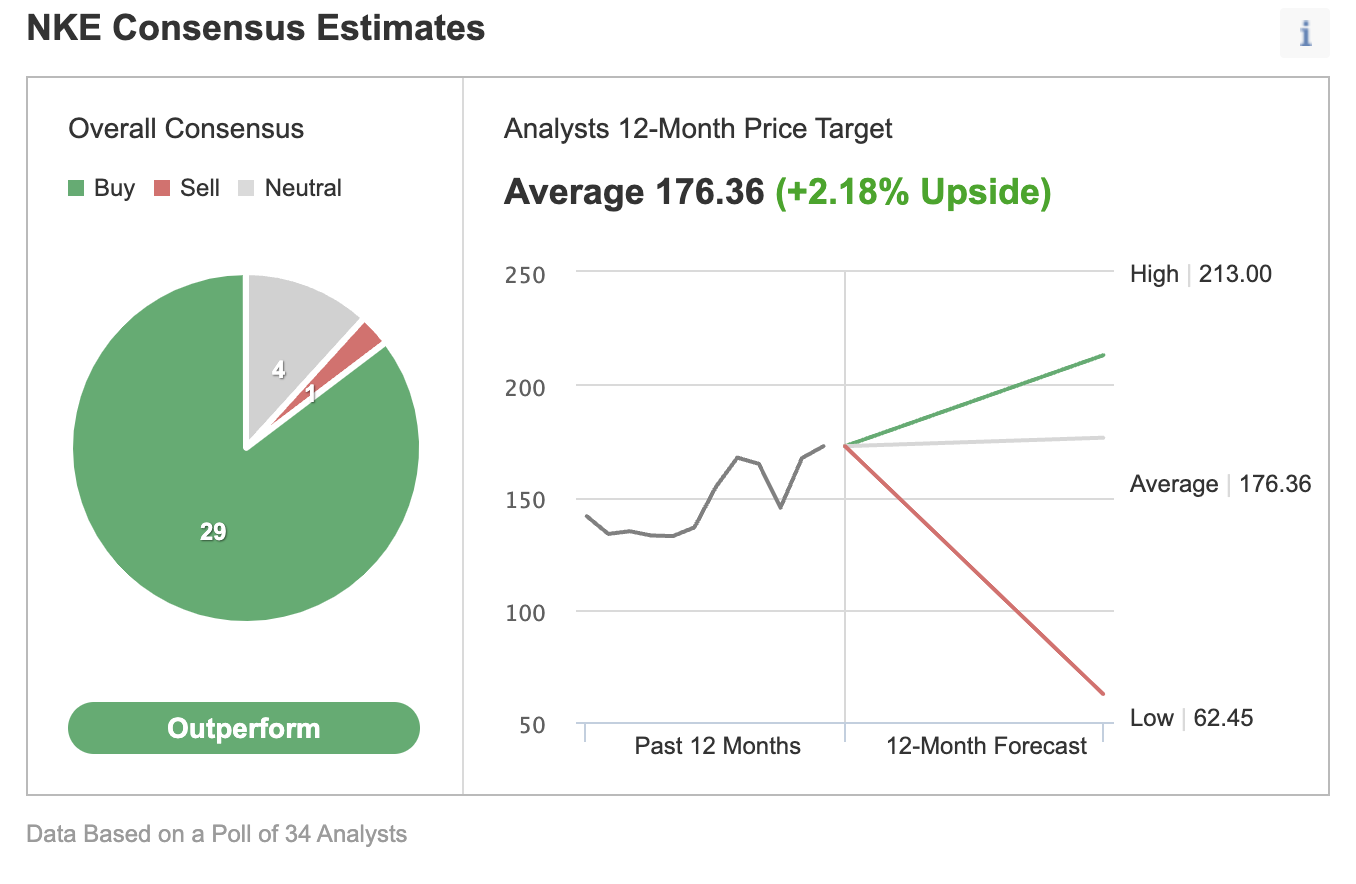Investors in sports apparel giant Nike (NYSE:NKE) have enjoyed robust gains so far in 2021. NKE stock is up 22.9% year-to-date. In the past month alone, shares returned close to 9%. It closed yesterday at $171.83.

The 52-week range for NKE stock has been between $125.44 (Mar. 25, 2021) - $179.10 (Nov. 5, 2021). The current price supports a dividend yield of 0.63%, and the company’s market capitalization exceeds $275.2 billion.
Nike released fiscal 2022 Q1 results on Sept. 23. Revenue came at $12.2 billion, up 16% year-over-year. The company reports revenue in two main segments:
- Nike brand (revenue of $11.64 billion, up 16% YoY);
- Converse (revenue of $629 million, up 162% YoY).
Also digital sales for the Nike brand went up by 29%. Net income was $1.9 billion, up 23% from last year. Diluted earnings per share of $1.16 also increased 22%. Cash and short-term investments were $13.7 billion, up about $4.2 billion YoY.
On the results, CEO John Donahoe said:
“NIKE’s strong results this quarter are continued proof of our deep consumer connections, unrelenting innovation pipeline and a digital advantage that fuels our brand momentum.”
However, management warned about supply-chain headwinds. Deliveries from factories in Vietnam, which is the second largest supplier of footwear to the U.S. behind China, have come under pressure. Due mostly to COVID-19 restrictions, a large number of apparel factories have been shut in southern Vietnam, leading to supply-chain issues for Nike.
Prior to the release of quarterly metrics, NIKE stock was trading around $160. But by Oct. 1, it was under $145. Since then, however, investors have hit the ‘buy’ button. On Nov. 5, shares saw a record high of $179.10. Now, they are around $173.65.
Next Move In NKE Stock?
Among 34 analysts polled via Investing.com, Nike shares have an “outperform” rating, with an average 12-month price target of $176.36. Such a move would imply an increase of more than 1.5% from the current level. The target range is between $62.45 and $213.

Source: Investing.com
In other words, Wall Street believes the share price now reflects all positive news at this point. We should also remind readers that management will issue Q2 results in the second half of December. Therefore, there could be increased choppiness in NKE shares soon.
Nike bulls with two- to three-year horizons who are not concerned about short-term volatility could consider buying the stock for long-term portfolios. Others, who are experienced with options strategies, might instead prefer to put together a "poor person's covered call" on the stock instead.
So, today we introduce a diagonal debit spread on Nike by using LEAPS options, where both the profit potential and the risk are limited. Such a strategy could be used to replicate a covered call position at a considerably lower cost, and also help decrease the portfolio volatility.
Investors who are new to the strategy might want to revisit some of our previous articles on LEAPS options first (for example, here and here) before reading further.
Diagonal Debit Spread On NKE Stock
Current Price: ~$173.65
A trader first buys a “longer-term” call with a lower strike price. At the same time, the trader sells a “shorter-term” call with a higher strike price, creating a long diagonal spread.
Thus, the call options for the underlying stock have different strikes and different expiration dates. The trader goes long one option and shorts the other to make a diagonal spread.
In this strategy, both the profit potential and risk are limited. The trader establishes the position for a net debit (or cost). The net debit represents the maximum loss.
Most traders entering such a strategy would be mildly bullish on the underlying security. Instead of buying 100 shares of NKE, the trader would purchase a deep-in-the-money LEAPS call option, where that LEAPS call acts as a “surrogate” for owning the stock.
For the first leg of this strategy, the trader might buy a deep in-the-money (ITM) LEAPS call, like the NKE 19 Jan. 2024, 130-strike call option. This option is currently offered at $56.05. It would cost the trader $5,605 to own this call option that expires in about two years and two months instead of $17,365 to buy the 100 shares outright.
The delta of this option is close to 80. Delta shows the amount an option’s price is expected to move based on a $1 change in the underlying security.
If Nike stock goes up $1 to $174.65, the current option price of $56.05 would be expected to increase by approximately 80 cents, based on a delta of 80. However, the actual change might be slightly more or less depending on several other factors that are beyond the scope of this article.
For the second leg of this strategy, the trader sells a slightly out-of-the-money (OTM) short-term call, like the NKE 21 Jan. 2022 175-strike call option. This option’s current premium is $8.05. The option seller would receive $805, excluding trading commissions.
There are two expiration dates in the strategy, making it quite difficult to give an exact formula for a break-even point in this trade. Different brokers might offer “profit-and-loss calculators” for such a trade setup.
Calculating the value of the back-month option (i.e., LEAPS call) when the front-month (i.e., the shorter-dated) call option expires requires a pricing model to get a “guesstimate” for a break-even point.
Maximum Profit Potential
The maximum potential is realized if the stock price is equal to the strike price of the short call on its expiration date. So the trader wants the NKE stock price to remain as close to the strike price of the short option (i.e., $175) as possible at expiration (on Jan. 21, 2022), without going above it.
Here, the maximum return, in theory, would be about $857 at a price of $175 at expiry, excluding trading commissions and costs. (We arrived at this value using an options profit-and-loss calculator). Without the use of such a calculator, we could also arrive at an approximate dollar value. Let’s take a look:
The option seller (i.e., the trader) received $805 for the sold option. Meanwhile, the underlying NKE stock increased from $173.65 to $175, a difference of $1.35 per share, or $135 for 100 shares.
Because the delta of the long LEAPS option is taken as 80, the value of the long option will, in theory, increase by $135 X 0.8 = $108.
However, in practice, it might be more or less than this value. There is, for example, the element of time decay that would decrease the price of the option. Meanwhile, changes in volatility could increase or decrease the option price as well.
The total of $805 and $108 comes to $913. Although it is not the same as $857, we can regard it as an acceptable approximate value.
Understandably, if the strike price of our long option had been different (i.e., not $130.00), its delta would have been different, too. Then, we would need to use that delta value to arrive at the approximate final profit or loss value.
Here, by not investing $17,365 initially in 100 shares of Nike, the trader’s potential return is leveraged.
Ideally, the trader hopes the short call will expire out-of-the money (worthless). Then, the trader can sell one call after the other, until the long LEAPS call expires in about two years and three months.
Bottom Line On Nike Shares
We believe NKE stock is a solid long-term choice for most retail portfolios. However, the upcoming earnings results in December might mean choppiness in Nike shares. Therefore, a trading strategy like the one outlined above might help decrease portfolio volatility.
